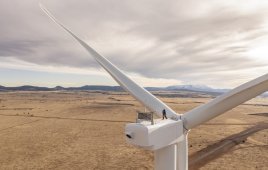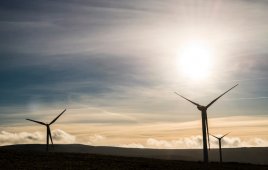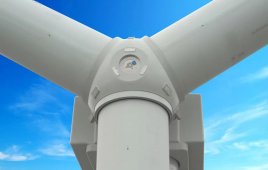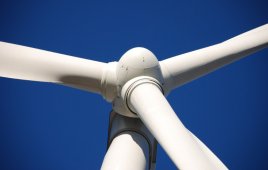Editor’s note:
Inventor Horia Nica has applied for a patent on a device that couples a vertical-axis wind turbine with a device that captures heat from passing wind, a capability conceived by early 20th century inventor Nicola Tesla. Furthermore, the captured thermal energy is transferred to the wind turbine as rotational kinetic energy, according to Nica. The Tesnic Inc website (tesnic.com) shows a few early concepts for such a device intended only for vertical-axis turbines. In a brief interview, Nica said he is now building a working model of the wind turbine and thermal-capture device that will allow extracting more energy from the wind than a turbine alone. The following white paper provides some mathematical validity for the idea.
–Paul Dvorak
On the possibility of overcoming Betz limit in wind-power extraction
Horia Nica,
Tesnic Inc.
Laval, Quebec, Canada
Tesnic.com
The energy in the wind has components of kinetic and heat energy. Existing wind technologies can extract only a fraction of the kinetic energy. The maximum theoretical value of kinetic energy extractable from the wind was demonstrated in 1919 by Albert Betz and it is known as Betz’s Law. According to it, the maximum coefficient of performance (Cp) in kinetic-energy extraction is 59.3%, which is also called the Betz Limit. Existing wind turbines actually have a lower Cp than the Betz Limit. What if the wind turbines could extract a portion of the heat energy from the wind in addition to its kinetic energy?
Assume an ideal wind turbine can extract the wind’s kinetic energy at the Betz Limit, 59.3% of the kinetic and that this ideal turbine has a frontal surface area of 100 m2 (10 m by 10 m). In a wind of 10 m/s and a temperature of 15 C, the energy extracted by such an ideal wind turbine is:
Ek= 0.5ρAV3Cp
Where Ek = kinetic energy in the wind, W; ρ = air density, kg/m3; A = area, m2; and V = wind speed, m/s. Then,
Ek = 0.5 * 1.225 * 100 * 1,000 * 0.593
Ek = 36,321 W , or
= 36.32 kW
After operating for one hour at these conditions, the turbine will produce:
Pk = 36.32 kWh
Now assume there exists a device that, if combined with the above ideal turbine, can extract a portion of the thermal energy in addition to the above calculated kinetic energy. Assume that with the device, a portion of the airflow exiting the turbine is slightly cooler than the input airflow. Assume 50% of the input airflow exits at 0.1° C lower.
In such case, the thermal power calculation is:
Pt = ρQair/hr ΔT Hair
Where Pt = thermal energy captured, kj; Qair/hr = volume of air flow per hour, m3/hr; ΔT = temperature difference, °C; and Hair = specific heat for air; kj/kg. Then
Pt =1.225 *( 100 m2 * 10 m/s * 3,600 s * 50%)* 0.1 * 1.005kj/kg
Pt = 221,602.5 kj
Knowing that 1 kilojoule (kj) = 0.0002777 kWh we obtain:
Pt = 61.55 kWh
The corresponding thermal energy is transferred to the wind turbine as rotational kinetic energy. Consequently the turbine in the above theoretical example, having a device that lowers the temperature of the exit airflow by only 0.1° C will be able to produce a total of:
Ptotal = Pk + Pt
= 97.87 kWh, which is 2.69 times more than the Betz Limit.
Therefore, in theory, wind power extraction can go beyond the Betz Limit and without contradicting Betz’s Law. The capability will result in future powerful wind turbines having smaller dimensions than current designs with the same capacity. Our recent patent application discloses a device able to capture the thermal energy as described above.
For more information, view Tesnic’s white paper here.
Filed Under: Turbines





Except
Einestines Modification that equal and opposite reractions producing the speed of light and man’s learning curve no wind blows between my invention blade or blades that fip to opppse there own infinitely thin edges.that do not exsist in Betz law it only serves to falsify the true values of world wide natural energy that supports oil nukes coal that are finite vrs infinite wind currents .valuss
The proposal violates the second law of thermodynamics. It is only possible to convert heat energy to work by harnessing the flow of heat from the source to a colder sink. The heat source in your calculations is at 15 degrees C and even if you had a sink at 0 deg C the maximum possible efficiency (Carnot) for a heat engine operating between these limits is 15/(15+273) = 5.2%
Of course no such sink exists and the extraction of thermal energy as described is impossible.
Due to financial struggles we have difficulties to build a proper prototype to validate our theory.
More than a year ago I asked the editors to make some corrections in the article as it seemed to be a mix-up between Energy and Power.
At that point in time put the error on the shoulders of the editors as the article was re-edited a bit from our original document.
I apologize for my mistake.
Recently, a young student, Philipp Jablonski, I believe from Germany (Ökumenisches Gymnasium zu Oberneuland ), pointed out that there still seem to be a confusion between the Energy and the Power in our calculations, more specifically in the unit of measures.
We checked again our paper and it turns out that he was right, as well as the initial comments made back in 2009.
The error was in the portion of thermal calculation as we considered that to be Power when in fact it was the energy.
The new document is much cleaner, the power does not intervene so we eliminated the confusion created by using the power and the energy in our calculations.
The corrections does not change the conclusion or the order of magnitude of Thermal energy extraction vs Kinetic energy extraction.
We are very grateful for all these comments that helped us improve our document.
Nothing is impossible being with in the energy coservation one can improvise means and way for brakethrough
Mr. Sadiq:
Thanks for your comment. The Betz limit suggests about 59% maximum possible power extraction by a wind turbine. The posted article’s subject was how to get more than that maximum and the proposed method was to extract heat from the passing as well as mechanical energy. When the researcher in the article presents a working prototype of such a turbine, I will be glad to write a story on it.
Paul Dvorak
Hi.”Nothing is more powerful than an idea whoes time has come” Tomas Edison . Betz limits miss calculates by allmost half the values of natural wind and currents. Claiming falsely , all are same.
Hi.”Nothing is more powerful than an idea whoes time has come” Tomas Edison . Betz limits miss calculates by allmost half the values of natural wind and currents. Claiming falsely , all are same.
Windpower Engineering Note:
It has come to our attention that some of the equations above were edited incorrectly. As we re-wrote the equations from Horia Nica, we failed to observe the difference between power and energy. We apologize for any misinformation provided and have made the necessary changes.
We all agree that Betz Limit cannot be violated in terms of kinetic energy extraction. And this is valid for all current wind technologies which extract only the kinetic energy from the wind. The article talks about the possibility to extract the thermal energy in addition to the kinetic energy. The fact that current wind technologies (with or without augmenters) cannot tap into that portion of wind energy does not invalidate that possibility.
Augmented wind turbines are not new and are well known in the industry. They are limited in terms of cost effective up-scaling and economical COE, and as a result are a fringe sector. Stating that they “beat” the Betz limit is an eye-catching headline, but at the same time an unfortunate technical mistake that’s easily debunked by taking a closer look. When Alfred Betz formulated his theorem for an open rotor, he recognized that the rotor diameter (and hence the swept area) was a convenient parameter for characterizing all of the energy entering the turbine system. The free-streamtube control volume is straight forward to draw and the theorem readily confirmed. The shrouded (augmented) rotor diameter is not an equivalent parameter for characterizing all of the incoming energy for an augmented wind turbine. That’s because projecting this area forward to the incoming freestream flow does not account for all the energy actually engaged in the augmented wind turbine energy balance; i.e., a larger “effective diameter” must be projected forward to account for all the energy entering the augmented wind turbine control volume. The important new energy exchange accounted using this new control volume (where the free-streamtube control volume is drawn further outboard then the physical limits of the outer shroud) is for the entrainment enhanced diffuser. This is where some of the incoming energy external to the rotor core flow is exchanged for further depressed pressure behind the rotor (beyond what can be expected for a non-enhanced diffuser). The Betz limit is properly observed once the correct streamtube and energy accounting are applied. In the spirit of the original Betz energy balance, augmented wind turbines DO NOT beat the Betz limit.
It is important to understand why such a limit has to exist. The following is a simplified explanation.
Let us assume that there is no such limit and we can build a turbine that captures ALL the wind energy.
The wind hits this turbine at a certain speed, loaded with energy. The air flows through the turbine and comes out at the other side with no energy as ALL the energy has been captured by this fantastic turbine.
However, air with no energy does not move because if it moved – it had some energy in it. So we have this amazing turbine – air flows in but does not flow out. It’s not just the energy that is captured by the turbine, but the air too.
The air has to flow out, and in order to do so it has to keep some energy with it. This is why a turbine will never be able to capture all the energy. It has to leave some for the air to be able to flow out.
Betz simply calculated the minimum energy that has to be left in the air in order to allow all the air to flow out.
By Shy Baratz CTO at WIndextra Ltd.
No — The Betz limit simply can’t be violated. Every time someone claims this, look closer. There’s always a problem with the energy balance or control volume assumptions. In short — Energy can never be created or destroyed in a closed system, and the free-stream tube control volume forms the proper “closed system” reference for assessing any type of wind energy converter. All forms of energy including sound, chemical, radiant/thermal, electrical, atomic, and mechanical/potential can theoretically interplay to varying degrees within the overall energy balance that witnesses the energy conversion process going from wind to electricity — But there’s no way to beat the Betz limit. To do so would mean that continuity or conservation of energy or both would be violated and thus cause us to completely re-write physics as we know it — Making such a discovery on par with the likes of Galileo, Newton, and Einstein combined.
The pressure recovery will take place after the rotor, so it has no impact on the energy extracted/transferred to the rotor.
The possibility of ice throw is a hazard of the HAWT design.
Ice will not be created by the extraction of thermal energy from the airflow.
Moreover, even if ambient conditions are favorable for icing, the device mentioned in the article prevents any throw away of the ice.
Based on an independent company report on Innowind design and concept following was their conclusion:
It is worthwhile to notice that any known wind turbine does not exceed the maximum value of the coefficient of performance predicted by Betz’ law:
Betz formular = 0.593
but the INNOWIND concept could lead to wind turbines that exceed the maximum value of the coefficient of performance predicted by Betz’ law.
So in the future by using both horizontal and vertical kinetic energy it is possible to be Betz law
This is a thought provoking document, which I hope generates some deeper analysis. In addition to the pressure recovery point of the prior comment, a couple of other points could be suggested:
The power of the thermal component of wind must be reduced by the thermodynamic cycle efficiency…for instance of a Rankine cycle…which means only a fraction of the potential thermal energy is available as useful power.
Today there is increasing awareness about \ice throw\ from Wind Turbines, which is an important siting consideration. If a device introduced cooler swept surfaces, then the likelihood of ice formation could be increased. Thus harvesting of thermal energy would be limited to ambients when icing could not occur, reducing the AEP of the thermal cycle.
you also need to account for PV=nRT – if you lower the temp the presure will be decreased and upon exiting the turbine the pressure will have to recover to the local conditions. This hould be addressed in the analysis.